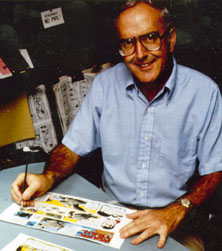 | |
| Occupation | |
|---|---|
Occupation type | Art profession |
| Description | |
Fields of employment | Publishing |
Related jobs | Editorial cartoonist Comics creator |
A cartoonist is a visual artist who specializes in both drawing and writing [1] cartoons (individual images) or comics (sequential images). Cartoonists differ from comics writers or comics illustrators/artists in that they produce both the literary and graphic components of the work as part of their practice.
Contents
- Terminology
- History
- Editorial cartoons
- Comic strips
- See also
- References
- Citations
- Works cited
- Further reading
- External links
Cartoonists may work in a variety of formats, including booklets, comic strips, comic books, editorial cartoons, graphic novels, manuals, gag cartoons, storyboards, posters, shirts, books, advertisements, greeting cards, magazines, newspapers, webcomics, and video game packaging.

